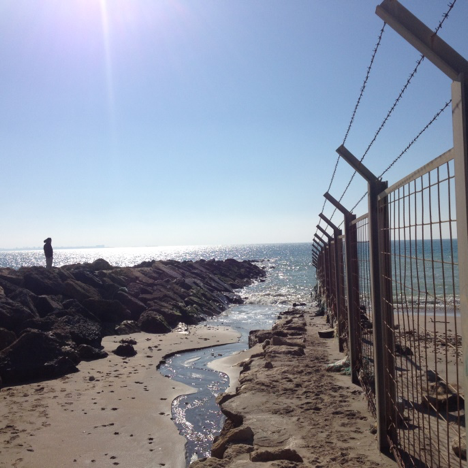by Sasha Flatau
‘Y aquí, otra frontera’
I’d been walking along a beach called Las Redes in El Puerto de Santa María, Spain with my boyfriend. It was a beautifully warm, sunny January afternoon and we’d got onto the conversation of borders. If you take away the political context, borders between different countries are such a strange concept. Surely if the world was equal and resources were fairly distributed, there would be no need for borders and freedom of movement would be a given. This was the turn our conversation had taken anyway.
We’d arrived at a metal fence with barbed wire that crossed the entire width of the beach, when my boyfriend said, ‘and here, another border’.

I thought it was a strange remark because it was just a fence. There were even holes in it that we could easily walk through to continue our walk. But he assured me that this was not the case. This was Naval Station Rota and if we walked through, to the other side of the fence, somebody would order us to leave via the megaphone. What looked like a beautiful empty beach was rigged with security cameras.
The Anthropology of Borders addresses such themes for instance, surveillance and governmentality. While Naval Station Rota is under the Spanish flag, the base and its facilities are shared by Spanish and US navies. Therefore, Spanish people often think of the base and refer to it as American territory. While this is not an international border, some of the themes touched by anthropological studies of international borders apply. As asserted by Fassin (2011: 1), “Anthropological studies highlight the renewed role of the nation-state to impose a surveillance apparatus of the frontiers and the territories…”

Interestingly, this border on the beach raised more questions for me than the border control at Malaga airport that I had encountered a couple of weeks before. When flying to a holiday destination, we take it for granted that there will be security checks. In fact, ‘there are more international borders in the world today than ever there were before’ (Wilson & Donnan, 2016: 1). As a result, we do not often question why they are there and what purpose they serve. Yet a metal fence and barbed wire across an empty stretch of coastline holds an air of incongruity. It is unnatural. Just as all borders are unnatural. Why should something as symbolic as drawing a line, building a fence or wall entail such processes of power and inflict meaning on stretches of space? Why should a stupid fence and security cameras dictate the end of my walk along the beach on a beautiful sunny day?
Sasha Flatau is studying for a Masters in Anthropology of Development and Social Transformation at the University of Sussex.
Further reading on the Anthropology of Borders:
Fassin, D. (2011). Policing Borders, Producing Boundaries. The Governmentality of Immigration in Dark Times. Annual Review of Anthropology, 40, 1-507.
Hannerz, U. (1997). Borders . International Social Science Journal, 537-548.
Kearney, M. (1991). Borders and Boundaries of State and Self at the End of Empire. Journal of Historical Sociology, 4(1), 52-74.
Kurki, T. (2014). Borders from the Cultural Point of View. Culture Unbound, 6, 1055–1070.
Spalová, B., & Grygar, J. (2006). Anthropology at Borders: Power, Culture, Memories. Praha: FHS UK a MKC Prague.
Wilson, T. M., & Donnan, H. (1998). Border identities: nation and state at international frontiers. Cambridge: Cambridge University Press.
Wilson, T. M., & Donnan, H. (2016). A Companion to Border Studies. New York: John Wiley & Sons.
Photo Credit: Sasha Flatau

